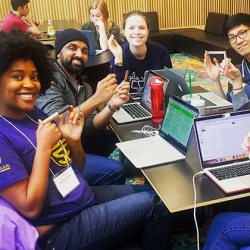The Executive Edge (Q3 2024) - Inside This Issue: AI, Employee Burnout, ESG Reporting

Welcome to the first edition of The Executive Edge, a new quarterly newsletter presented by Michigan Ross Executive Education, designed to bring you the latest insights and expert analysis on the most pressing issues facing business leaders and HR leaders today.
Inside This Issue: AI, Employee Burnout, and ESG Reporting. Featuring Professors Nigel Melville, Amy Young, and Gwen Yu.
Each edition of this newsletter will feature a curated selection of news articles organized by trending topics, followed by expert commentary from Michigan Ross faculty aimed to empower you with forward-thinking insights and perspectives to navigate and thrive in today’s dynamic global business landscape.
If you have questions or comments about this newsletter or want to learn more about executive education solutions to this issue’s topics and beyond, please contact us at RossExecEd@umich.edu.
AI in the Workplace
- Accenture: Accenture Report Finds Perception Gap Between Workers and C-suite Around Work and Generative AI
- Bloomberg Law: Humans Should Oversee AI at Work, White House Tells Employers
- CNBC: Workers are secretly using AI on important tasks over fears it makes them look replaceable, new Microsoft and LinkedIn research finds
- Deloitte: Generative AI in Asia Pacific: Young employees lead as employers play catch-up
- Microsoft: 92% of Indian knowledge workers use AI in the workplace, finds Microsoft and LinkedIn 2024 Work Trend Index
- Reuters: More than 40% of Japanese companies have no plan to make use of AI
- World Economic Forum: Women are at risk of being left behind in the generative AI workplace revolution
Headline Highlights: Developments in AI continue to evolve rapidly while business leaders remain intrigued but cautious about the potential uses of AI in the workplace. As they and HR leaders anticipate the need for new skills to keep pace, a notable perception gap exists between workers and executives regarding AI's role, with many employees using AI discreetly due to fears of job displacement. While some organizations lag in AI adoption, younger employees lead the charge. The rise of AI also presents risks, including potential disparities in the workplace.

Expert Perspective from Nigel Melville, Associate Professor of Information Systems, Michigan Ross:
What can business leaders do to better understand AI’s actual capabilities and its broader impact beyond just productivity gains, and how can they better align AI strategies with the actual needs and perceptions of their workforce?
Modern AI emerged against a background of waves of technological change (cloud computing, big data, etc.). As such, there is a solid foundation of knowledge concerning digital transformation and innovation that applies equally well to the AI space: technical vocabulary and intuition, generating value with tech, and understanding governance issues such as ethics, regulation, data privacy, and cybersecurity. Viewing AI as distinctive but simultaneously part of a long line of technological change can add valuable perspective and support productive learning journeys.
AI presents new opportunities to enhance efficiency and effectiveness. It also presents an opportunity to learn from employees about drudgery and pain points in their already long list of to-dos. What is this drudgery, and how can AI mitigate or eliminate it and create more room for non-drudgery functions? Asking these types of questions may help to align AI.
How do you see the future of human-AI collaboration in the workplace, and what should leaders do to prepare their teams for this shift?
It is always difficult to see the future. But one future that I seek to create through my research and engagements with the business world is one in which the use of AI is transparent whenever it is used, special safeguards are put in place for vulnerable populations and in high-risk contexts (perhaps mandated by regulatory agencies), and those deploying AI are held responsible and accountable when something goes wrong. Regarding human-AI collaboration, we need to understand better how humans learn from machines, how humans prefer to team with machines, and how humans can manage groups of humans and machines working together.
What are the potential long-term consequences for businesses where C-suite executives fail to recognize the full scope of AI adoption by their teams?
Based on emerging research, including my own, it seems likely that AI will have a modest to significant impact across most industries. This likelihood means that large organizations would be wise to develop an AI framework, i.e., a plan for how they will navigate an effective AI journey. For some, this means identifying near-term opportunities, developing and testing pilots, and scaling to production as necessary. For others, adding leadership or board members with AI skill sets (ideally, incorporating both technical and business dimensions) may be appropriate. Finally, a long-term strategic perspective may also be appropriate in many contexts, given the potential for AI to significantly alter how value is created in numerous domains and industries.
Employee Burnout and Well-being
- BCG: Half of Workers Around the World Are Struggling with Burnout
- CNBC: Top 10 countries where workers are thriving most, according to a new Gallup report
- Fortune: Nearly all HR leaders who track their well-being programs say they turbocharge productivity
- Hindustan Times: 86 percent of Indian employees are struggling or suffering
- Michigan Ross: New Study from Executive Education Faculty Explores the Relationship Between Leadership Communication and Burnout in Healthcare
- PR Newswire (The Conference Board): Tackling the Mental Health Crisis: 42% of Companies Plan to Offer New Employee Well-Being Benefits
- Staffing Industry Analysts: Southeast Asian countries lead the way in workplace stress
Headline Highlights: Despite increased investments in employee wellbeing initiatives, burnout rates surged during the pandemic and show little sign of decline even years later, indicating a persistent and ongoing challenge for employees, employers, and HR leaders across the globe. The detrimental effects of burnout extend beyond individual well-being, impacting productivity and organizational culture.

Expert Perspective from Amy Young, Teaching Professor, Business Communications, Michigan Ross:
What first steps should leaders take to address burnout, and how can they create an open environment where employees feel comfortable discussing their stress and burnout concerns?
The first step leaders should take to address burnout is to have a conversation about it with their teams. Often, employees are reluctant to speak up when they are experiencing burnout, making leaders the last to know how serious a problem it is. By making it a group effort to solve the burnout issue, employees will feel less alone and can work collectively to change how they work together.
I also suggest leaders focus on changing the workplace practices that are both detractors and enablers of well-being. Detractors include role ambiguity, time pressures, and interpersonal conflict, for example. Enablers involve building meaning, connections, and positive emotions while at work. Enablers are just as important because they increase energy and the ability to be productive, and just as importantly, they bring hope and vitality that uplifts teams.
How do leadership communication styles influence employee well-being and burnout levels?
One enabler of workplace well-being that I found effective in my own research is leadership communication. Simply changing how leaders interact with employees throughout the workday can immediately impact their well-being and productivity. This impact occurs because positive social interactions create what's called relational energy, a heightened sense of resourcefulness that enhances one's capacity to do work. There is a body of research demonstrating that relational energy improves how we feel, our physical health, and productivity at the individual, team, and organizational levels. All of this comes from simply being more purposeful in the way leaders engage others at work.
What strategies can companies employ to ensure the long-term sustainability of well-being initiatives rather than seeing them as short-term fixes?
When leaders ask how to ensure the sustainability of workplace well-being, I tell them to make it a group effort, action-oriented, and ongoing until new workplace habits and norms are established. By bringing it to the team, employees can experiment with different ways of getting work done that are more efficient, productive, and energizing. Many workplace practices have demonstrated success in improving well-being, but not all speak to a company's unique needs. You won't know until your team tries them out. There are many viable solutions for addressing burnout, but instead of relying on wellness programs, we need to reimagine how we can get work done and engage each other. The key lies in an open mindset, experimenting with new ways of work, and sustaining the effort until new habits and norms are established.
ESG and Reporting Frameworks
- Bloomberg Law: Conflicting ESG Reporting Rules Create Major Business Challenge
- ESG Today: 80% of Companies See Sustainability as a Potential Revenue, Profitability Driver: Morgan Stanley Survey
- ESG Today: China Stock Exchanges Announce Mandatory Sustainability Reporting Requirements for Companies
- Forbes: California Moves To Delay Corporate Climate Reporting Requirement Until 2028
- Industry Dive: Sustainability reporting, ESG management roles on the rise: Deloitte
- Industry Dive: 93% of firms use a mix of ESG standards, thwarting uniformity efforts: IFAC
- SAP: 86% Of Indian Businesses See Positive Relationship Between Sustainability and Business Profitability: SAP Sustainability Study
Headline Highlights: Global businesses are grappling with the complexities of conflicting ESG reporting rules alongside new regulations, while many companies simultaneously recognize sustainability as a driver of revenue and profitability. The rise in sustainability reporting and ESG management roles underscores a broader commitment to integrating these principles into business strategies.

Expert Perspective from Gwen Yu, Professor of Accounting, Michigan Ross:
What are some of the main challenges companies face in the global sustainability reporting landscape?
One of the key challenges is interoperability—the ability of different reporting frameworks to work together. Various sustainability standards have been developed with distinct goals in mind. For instance, in the U.S., sustainability reporting primarily aims to provide investors with information to assess the risks and opportunities that firms face due to environmental and social factors. Meanwhile, in the EU, the focus is broader, encompassing the impact that firms have on their external environment and communities. These differing objectives require different types of information. Additionally, the scope of sustainability reporting often extends beyond traditional corporate boundaries, which means many organizations may need to comply with multiple reporting standards simultaneously.
How might the future of sustainability reporting evolve in the next few years?
Most jurisdictions have prioritized an "environment-first" approach, and we have made good strides in environmental ("E") disclosures. The next major focus will likely be the social factor ("S"), which covers how companies interact with their employees and the communities in which they operate. Measuring the social factor presents unique challenges. Unlike environmental metrics, which often have quantifiable indicators, social factors revolve around policies and behaviors, which lack a clear measurement tool. Even if consensus is reached on how to measure these factors, determining what constitutes a desirable outcome is subject to greater debate.
As more countries move towards mandatory sustainability reporting, what should companies and leaders do to adapt proactively?
Leaders should consider how to move beyond mere compliance and use sustainability reporting as a tool for driving organizational change. One of the strongest arguments for mandating sustainability reporting is that it can shift corporate behavior. The idea is that requiring firms to disclose their environmental and social impacts will incentivize them to prioritize these areas in ways the market alone cannot achieve. Transparency can shine a light on externalities that companies may have previously overlooked. Since many organizations have not traditionally focused on these issues, it's crucial to build internal capacity around sustainability topics that are material to the business. A good starting point is to develop a focused, strategic approach tailored to the company's unique needs and impact.
Get in Touch with Michigan Ross Executive Education
Whether you are considering executive development for yourself, someone on your team, or a group within your organization, Michigan Ross is committed to your short—and long-term success. Connect with us to see how we can work together to reach your goals.








